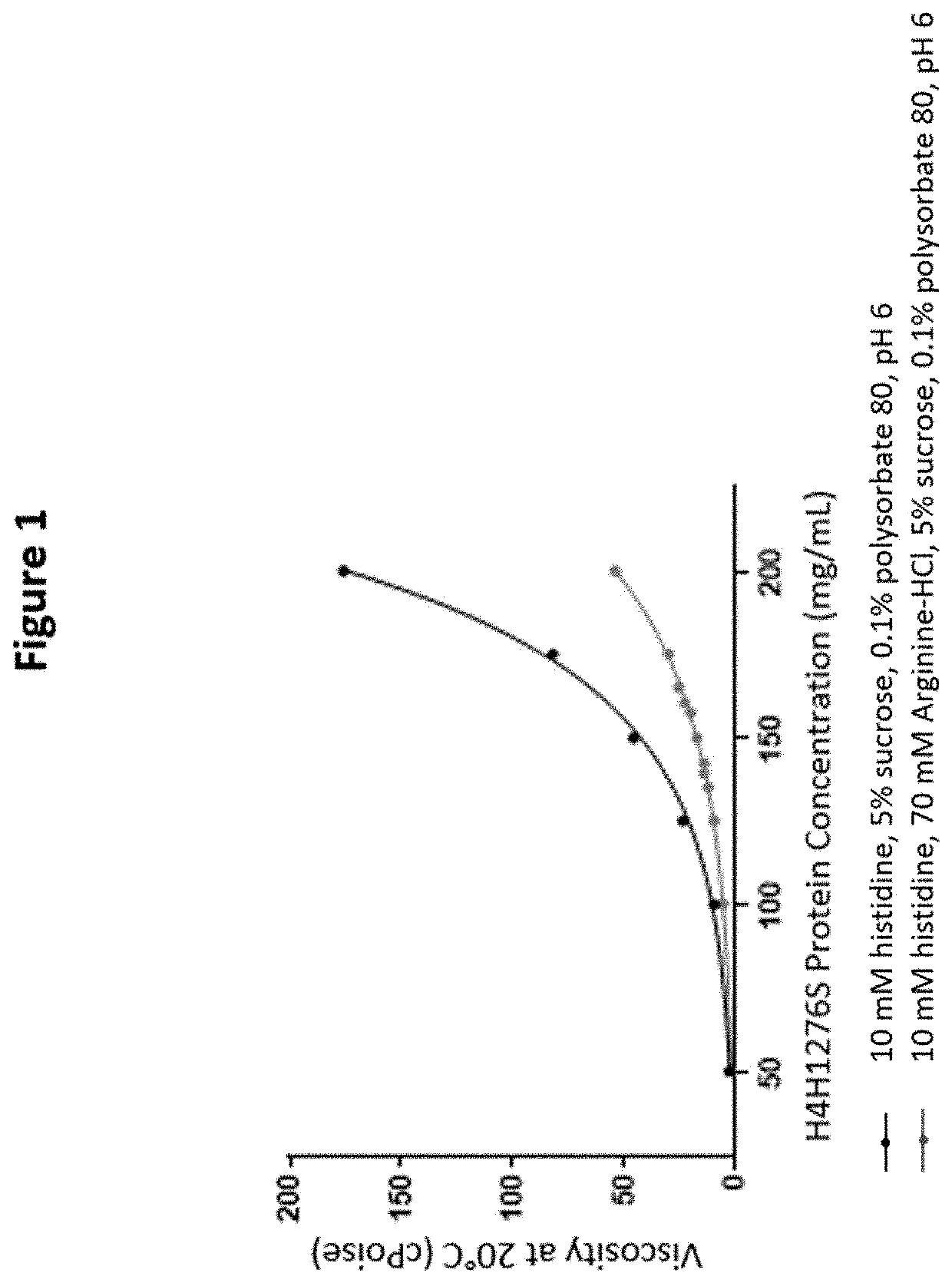Stabilized formulations containing Anti-angptl3 antibodies
a technology of antiangptl3 and formulation, which is applied in the field of stabilized formulations containing antiangptl3 antibodies, can solve the problems of affecting the ability of patients to deliver drugs and large effects, and achieve the effects of small injection volume, small dosing volume, and high protein concentration formulation
- Summary
- Abstract
- Description
- Claims
- Application Information
AI Technical Summary
Benefits of technology
Problems solved by technology
Method used
Image
Examples
example 1
Development of an Anti-ANGPTL3 Antibody Formulation
[0156]For later stage clinical development, both IV and SC administrations of higher doses were planned. Therefore, formulation development studies were conducted with the goal of developing a 150 mg / mL liquid formulation that can be used for either IV or SC injection. A high concentration liquid formulation is required for delivering doses of H4H1276S, up to 450 mg, with one or two SC injections. For IV administration, a high concentration liquid formulation is also advantageous, because it permits addition of a smaller volume of DP to the IV infusion bag. This supports the use of doses as high as 15 mg of H4H1276S per kg patient weight.
[0157]Initial formulation development activities for the lyophilized H4H1276S formulation were conducted at a low protein concentration (5-50 mg / mL H4H1276S) and included an assessment of buffers, pH, organic co-solvents, surfactants, and sucrose to identify excipients that enhance protein stability...
example 2
Exemplary Formulations
[0163]In certain embodiments, mAb1 is formulated as an aqueous buffered formulation containing from 5 mg / ml±0.75 mg / ml to 250 mg / ml±45.0 mg / ml mAb1, 10 mM±2 mM histidine, 0.1%±0.05% w / v polysorbate, 50 to 75 mM Arginine-HCl, and 1%±0.02% to 5%±1% w / v proline, at pH 6.0±0.3. Exemplary formulations include: 150 mg / mL H4H1276S, 10 mM histidine, pH 6.0, 70 mM Arginine-HCl, 0.1% (w / v) polysorbate 80, and 3% (w / v) proline.
example 3
Methods Used to Assess Formulation Stability
[0164]The physical stability of a formulation refers to properties such as color, appearance, pH, turbidity, and protein concentration. The chemical stability refers to the formation of high molecular weight (HMW) species, low molecular weight (LMW) species, charge variants, and other chemical modifications of the protein. The physical and chemical stabilities of antibody drug product (for example, H4H1276S) were assessed using the following assays:[0165]Color and appearance by visual inspection (presence of visible particulates in solution can be detected)[0166]pH[0167]Turbidity measured by increase in optical density (OD) at 405 nm[0168]Subvisible particulate analysis by Micro-Flow Imaging™ (MFI)[0169]Protein concentration by reversed-phase ultra performance liquid chromatography (RP-UPLC), reported as percent protein recovery relative to the starting material[0170]Purity by the following assays:[0171]Size exclusion ultra performance liq...
PUM
 Login to View More
Login to View More Abstract
Description
Claims
Application Information
 Login to View More
Login to View More - R&D
- Intellectual Property
- Life Sciences
- Materials
- Tech Scout
- Unparalleled Data Quality
- Higher Quality Content
- 60% Fewer Hallucinations
Browse by: Latest US Patents, China's latest patents, Technical Efficacy Thesaurus, Application Domain, Technology Topic, Popular Technical Reports.
© 2025 PatSnap. All rights reserved.Legal|Privacy policy|Modern Slavery Act Transparency Statement|Sitemap|About US| Contact US: help@patsnap.com



